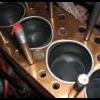Stainless Rear Subframe Mounting Bolts
#1

Posted 10 July 2007 - 11:25 AM
I know there 5/16" UNF what lengths are required?
#2

Posted 10 July 2007 - 11:30 AM
Against, bolts aren't mild steel but they are about a 1/3rd stronger than stainless.
Get some good quality BZP ones and bake them in the oven
#3

Posted 10 July 2007 - 11:32 AM
#4

Posted 10 July 2007 - 11:36 AM
mixing materials, you may have galvanic corrosion, unless you have both materials insulated from each other
Very good point as it'd be the less "nobel" captive nuts in your shell that would rot.
#5

Posted 10 July 2007 - 11:47 AM
You have called them "mild steel". They are not mild steel. U.S. and European bolt designations are different, but suffice it to say that the bolts on the Mini subframe are at least "Grade-5" which are typically indicated by three (3) tick marks on the bolt heads. These are not mild steel, they are typically a chrome-molly steel with a lot of toughness.
Stainless can be made "hard" but it's difficult to get it both hard and tough. 300 series stainless (and related 18-8) which are common stainless bolt materials are soft and only achieve hardness from work-hardening during manufacturing. They cannot be heat treated. 400 series stainless can be hardened (think stainless pocket knives) but has relatively low toughness. Threads on parts made of 440 stainless break off easily and the bolts can shear. The precipitation hardening grades of 13-5, 17-7 and others are a compromise between the two and still not as good as a common Grade-5 bolt.
Please don't post that company X or Y has special "this that or the other" stainless bolt until you've compared the strength of their fastener (and equally important... its price) to the "standard" subframe bolt which is a known entity capable of carrying the load the car is subject to. If you're worried about the parts seizing up, use anti-seize compound or liberally coat both the bolt threads and the weld-nut threads with Loctite to exclude moisture.
#6

Posted 10 July 2007 - 11:59 AM
Thanks DK I'd forgotten about imperial grade markings - I tend to use what I have with UNF fasteners. Would that be about equivalent to an 8.8 metric fastener?
Also, is there really any point in baking BZP to avoid enbrittlement? I'd imagine if it's effective they'll do it during production.
Good loctite tip, I can see me using loads more now!
#7

Posted 10 July 2007 - 01:04 PM
#8

Posted 10 July 2007 - 01:26 PM
The limiting factor will be the captive nuts on the car body whatever you screw in will depend on those half a dozen threads. Can't see any point in using anything with a higher tensile strength - as long as it's at least as strong go for whatever will survive living under your Mini.
Oh, and set the torque correctly, over tighten them and the fasteners will yield, leading to problems when you try to undo them - again fasteners that are otherwise identical apart from material grade will torque up differently.
#9

Posted 10 July 2007 - 02:54 PM
In general, throw out the ".9" portion of the metric fastener's grade and this defines its ultimate tensile strength in (hundreds of) MPa. So, a grade 10.9 metric fastener has a yield strength of 1000 MPa. Therefore, 12.9 fasteners have an ultimate tensile strength = 1200 MPa which corresponds roughly to the 180,000 psi yield of an imperial socket head cap screw. Grade-8, as used in hex heads, is just a bit lower at 150,000 psi. Grade-5 is a more common imperial fastener and it yields close to 120,000 psi which makes it comparable to about a metric grade 8.8
Regarding "BZP", I'm not familiar with the acronym, is that zinc plating? Zinc plating is typically not done on any fastener higher than grade 8.8 (metric) or grade-5 (imperial). Hydrogen embrittlement from the plating process seriously lowers the UTS of the alloy steels used in the high-strength fasteners. I have heard that you can bake the fasteners after plating to relieve most of the affect of the hydrogen but you'll notice that most high-strength bolts are either black oxide coated or have zinc-chromate instead of zinc plating. The chromate coating is that gold-green coating and it's not applied using the same process as electro-plating.
The general guideline on the nuts or tapped holes is to use a material of comparable strength to the bolt. So, as Ethel stated, using a super high strength bolt won't allow you to torque that much higher because you run the risk of stripping the tapped hole. What you do gain is higher shear strength (sideways) for the same level of torque. Another rule of thumb is that you want at least one times (1 x) the diameter of the fastener for the tapped hole in steel. For alumium you want 1.5-2.0 times the bolt diameter in thread engagement. On our cars we generally don't control this but if you're making or fixing a part, tapping deeper so you can use more thread engagement will allow you higher torques.
#10

Posted 10 July 2007 - 03:23 PM
I know the 4off that go into the captive nuts in the heal board are 2 1/2" long what about the rears located in the boot?
#11

Posted 10 July 2007 - 03:44 PM
#12

Posted 10 July 2007 - 04:01 PM
As for bright zinc plate vs. chromate... my car is a bit older than most of the cars on this forum so I couldn't tell you a place to look for the chromate color. However, I did Google for examples and found this informative link:
http://429mustangcou...new_page_26.htm
This web page has images showing various coating appearances.
I stand corrected though, I did not remember that there is a silvery/satin zinc chromate as well as the yellow I see more frequently. Apparently what I was thinking of is "zinc dichromate", not zinc chromate. Sorry for misleading you.
#13

Posted 10 July 2007 - 04:07 PM
Sorry, I can't help with the fastener lengths. I'd have to take the bolts off my car to tell you.
As for bright zinc plate vs. chromate... my car is a bit older than most of the cars on this forum so I couldn't tell you a place to look for the chromate color. However, I did Google for examples and found this informative link:
http://429mustangcou...new_page_26.htm
This web page has images showing various coating appearances.
I stand corrected though, I did not remember that there is a silvery/satin zinc chromate as well as the yellow I see more frequently. Apparently what I was thinking of is "zinc dichromate", not zinc chromate. Sorry for misleading you.
Dichromate - is that specially made for the Welsh because of the extra dampness?
#14

Posted 11 July 2007 - 12:05 PM
Anyway, that would be Dai-chromate wouldn't it? I think he works down a mine near somewhere I can't pronounce!
Just use the standard bolts, and coat the threads and shanks with copper slip. It's worked for fifty years and still does. Stainless isn't just not high tensile, it's actually brittle. Holding anything important or subject to a lot of force to the car with stainless is bad. Cap heads are a lot thicker than hex heads and I think they would interfere with the radius arm brackets, preventing them seating properly. I'm all for improving the nuts and bolts where they need it, but these don't. The one thing that is almost gauranteed with a rear subframe is that it will rust out long before the standard bolts age to any serious degree. So long as they can't rust or seize in place that's good enough.
Edited by Dan, 11 July 2007 - 12:07 PM.
#15

Posted 17 July 2007 - 10:41 PM
I sell Stainless fastenings for car restoration and have used them all over my own mini without problem for over 10 years and have many satisfied customers. The limiting factor on the subframe mounts is the bodyshell metal. This will yeild before the bolts. I know of autotest minis using stainless bolts on the frames and altough the speed isnt high the loading is! On the subject of strength just think how easy it was to break the old bolts whilst you tried to remove them after the corrosion had set in ( and they are "plated" when new). Using a class 70 or 80 cold formed rolled thread stainless bolt will be fine - DO NOT use anything that has been turned from Hex bar or been tapped onto a blank.
There are places I wouldnt consider selling bolts for on the mini and these include Brake Calipers ( V high grade), Drive flange ( again V high grade) and Seatbelt mounts (very complex laws about head shape - you must use genuine bolts).
On a final note - there is no "perfect" bolt - everthing is a trade off, high tensile strength equals low ductility etc etc.
1 user(s) are reading this topic
0 members, 1 guests, 0 anonymous users
















